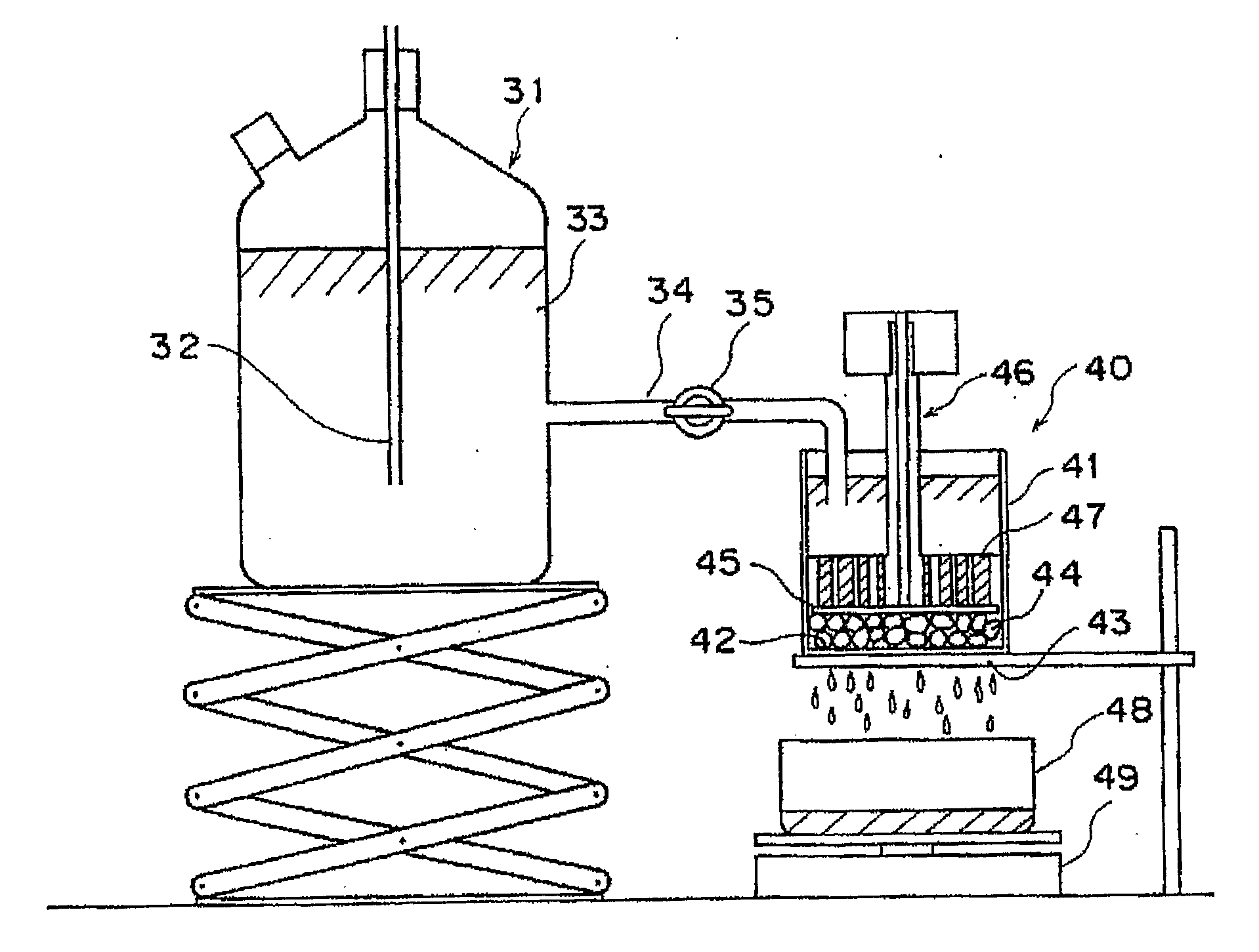Particulate water absorbing agent and production method thereof
a technology of absorbing agent and particulate water, which is applied in the direction of other chemical processes, cellulosic plastic layered products, natural mineral layered products, etc., can solve the problems of insufficient improvement of coloring, lower properties, and higher cost, and achieve excellent water absorption ability and excellent coloring prevention
- Summary
- Abstract
- Description
- Claims
- Application Information
AI Technical Summary
Benefits of technology
Problems solved by technology
Method used
Image
Examples
production example 1
[0176]A commercial acrylic acid (superfine reagent produced by Wako Pure Chemical Industries, Ltd.: containing 200 ppm of p-methoxyphenol) obtained by gas phase contact oxidization was supplied to a bottom of a high boiling impurity separation cylinder including 50 porous plates having no dam, and the acrylic acid was distilled at a reflux ratio of 1, and the resultant was further distilled again, thereby obtaining acrylic acid (0) made of 9.9% or more of acrylic acid and a minute amount of impurity (mainly water). In the acrylic acid (0), an amount of p-methoxyphenol was ND (less than 1 mass ppm) and each of amounts of protoanemonin, furfural, β-hydroxypropionic acid, and acrylic acid dimer was ND (less than 1 mass ppm). Further, in the acrylic acid (0), an amount of phenothiazine was 0 ppm, each of amounts of aldehyde and maleic acid was 1 ppm or less, and each of amounts of acetic acid and propionic acid was 20 ppm.
[0177]Subsequently, 50 ppm of p-methoxyphenol was added to the ac...
production example 2
[0180]The same operation as in Production Example 1 was carried out except that D,L-malic acid was not used, thereby obtaining a hydrogel cross-linked polymer (2). The resultant hydrogel cross-linked polymer (2) and 0.2 mol % (with respect to the entire unsaturated monomer) of D,L-malic acid were mixed with 50 mass % malic acid aqueous solution for an hour by using the sigma type double-arm kneader, thereby obtaining a hydrogel cross-linked polymer (3).
example 1
[0181]The hydrogel polymer (1) was spread out on a metal gauze whose mesh size was 850 μm, and was dried by hot air at 180° C. and at dew point of 70° C. for 90 minutes. A dry polymer thus obtained was crushed by using a vibrating mill, and then classified by using a JIS 850 μm standard sieve. Thus, dry powder particles (1) having passed through the sieve was obtained (average particle diameter was 300 μm, σζ was 0.35, particles whose particle diameter was less than 150 μm was 2%). Subsequently, in 100 parts by mass of thus obtained dry powder particles (1), a surface cross-linking solvent including 0.4 parts by mass of 1,4-butanediol, 0.6 parts by mass of propyleneglycol, 3.0 parts by mass of ion exchange water, and 0.5 parts by mass of isopropanol (“parts by mass” is indicative of a mass ratio with respect to the particles having passed through the sieve), was sprayed and mixed. Further, the mixture was then thermally processed at 210° C. for 40 minutes, thereby obtaining surface ...
PUM
| Property | Measurement | Unit |
|---|---|---|
| Length | aaaaa | aaaaa |
| Percent by mass | aaaaa | aaaaa |
| Percent by mass | aaaaa | aaaaa |
Abstract
Description
Claims
Application Information
 Login to View More
Login to View More - R&D
- Intellectual Property
- Life Sciences
- Materials
- Tech Scout
- Unparalleled Data Quality
- Higher Quality Content
- 60% Fewer Hallucinations
Browse by: Latest US Patents, China's latest patents, Technical Efficacy Thesaurus, Application Domain, Technology Topic, Popular Technical Reports.
© 2025 PatSnap. All rights reserved.Legal|Privacy policy|Modern Slavery Act Transparency Statement|Sitemap|About US| Contact US: help@patsnap.com



